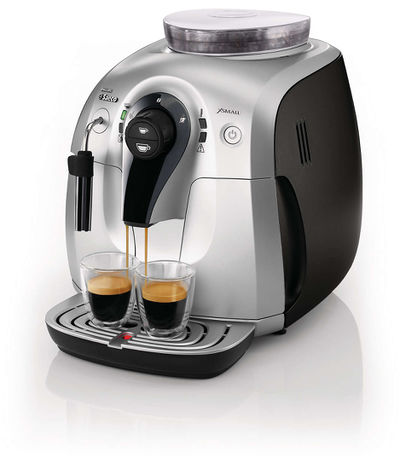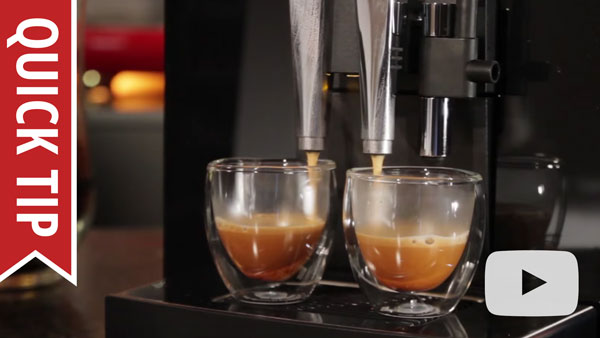Saeco XSmall
From Whole Latte Love Support Library
The Saeco XSmall is a super-automatic espresso machine {{{machine_short_descrip}}}.
| Saeco XSmall |
|---|

|
| Manufacturer: Saeco |
| Model Name: XSmall |
| Model Number: HD8743/11 |
| Type: Super-Automatic |
Contents
[hide]- 1 Machine Description
- 2 Basic Usage
- 3 Cleaning & Maintenance
- 4 Troubleshooting
- 4.1 No Crema or Bad Tasting Shots
- 4.2 Difficulty Frothing
- 4.3 Flow Issues
- 4.4 Machine Is Leaking
- 4.5 Machine Not Heating Or Powering On
- 4.6 Empty Grounds Light Stuck On Or Blinking
- 4.7 Fill Water Light Stuck On
- 4.8 No Beans Light Stuck On
- 4.9 Descale Light Stuck On
- 4.10 Alarm Light Flashing
- 4.11 Top Lights Blink Simultaneously
- 4.12 Brew Unit Stuck
- 4.13 Too Much Steam/Milk Boiling
- 5 Diagrams & Manuals
- 6 Specifications
Machine Description
{{{machine_long_descrip}}}
Basic Usage
Cleaning & Maintenance
Proper machine maintenance is critical to proper machine functionality. Most machine failures are caused by a lack of cleaning and maintenance. This is vital, as many manufacturer warranties do not cover cleaning/maintenance related breakdowns. To avoid this, it is imperative to keep a regular maintenance schedule. Consult pp. 36-53 in your machine manual for fully detailed cleaning procedures, including descaling, carafe cleaning, and brew group cleaning, as well as the recommended products for machine maintenance. Listed below is a suggested maintenance rundown for most super-automatic espresso machines:
Machine Maintenance
Descaling
Descaling the machine should be done on a bimonthly basis using the product recommended by the manufacturer. Descaling is still required even if reverse osmosis, distilled, or zero water is being used. Refer to your machine manual for specific instructions for this unit.
Brew Unit
The brew unit of the machine should be removed on a weekly basis and rinsed off with cold water. Cold water must be used because hot water can wash away the lubricant that coats the moving parts of the brew unit. It is also important to use plain water; detergents and soaps should not be used. While the brew unit is removed, the brew unit chamber should be wiped down with a moist cloth to remove excess grounds and coffee residues.
Your machine features a brew unit cleaning cycle. This should be done on a monthly basis; refer to your manual for instructions on how to run one.
A complete disassembly, cleaning, and lubrication of the brew unit should be done every 500 cups or every 6 months, whichever comes first. A food safe silicone-based lubricant should be used, such as food grade Petrol-Gel.
Steam Wand Cleaning
Steam wands and nozzle attachments should be cleaned daily, after the machine is finished for the day. Milk residues quickly build up in steam wands and frothing nozzles, so it is important to keep these clean to prevent blockages from forming.
Recommended Cleaning Products
The best descaling product for this machine is Durgol Swiss Espresso Descaler. The suggested tablets for running brew unit cleaning cycles are the Gaggia Coffee Clean Tablets or Urnex Full Circle Espresso Machine Cleaning Tablets.
Troubleshooting
No Crema or Bad Tasting Shots
Typically, issues with crema or the flavor of the shot do not indicate a malfunction of the machine. Instead, this indicates that an adjustment needs to be made in the brewing process or that different beans need to be used.
The type of bean that is being used is particularly important for super-automatic machines, because the built in burr grinders only accept certain types of beans. Another consideration is the roast of the bean, which greatly influences how much crema can be produced, as well as the flavor of the shot. Super-automatic machines are not compatible with oily, caramelized, or flavored beans. Properly stored and recently roasted beans are best. You can find more information on why bean selection and storage is important for super-automatic machines by watching the video below.
Appropriately adjusting the grinder is also important. Poor shots can also be the result of incorrect grind settings.
- If the shot is too bitter:
- The grind is set too fine. Try adjusting the grind to a coarser setting, typically indicated by a large dot symbol or higher number.
- If applicable, the aroma setting is set too high. Lower the aroma setting so that less coffee is ground per shot.
- The beans being used are over-roasted, and a lighter roast is needed.
- If the shot is too sour or weak tasting:
- The grind is set too coarse. Try adjusting the grind to a finer setting, indicated by a lower number. Whenever moving the grind to a finer setting it is important to make minor adjustments, and to only adjust the grinder while in operation.
- If there is little crema:
- The beans are probably stale and fresher beans need to be used.
- The grind setting does not match the drink that is being made. Smaller drinks such as an espresso require finer grind size; larger drinks such as a longo require a coarser grind.
- Oily or dark roasted beans are being used. These beans are not compatible with the unit, and are not suitable for espresso brewing. The oils and chemicals that are needed to produce a rich crema have been roasted out of the bean. Switch to a drier/lighter roast.
- Keep the machine properly cleaned and maintained for good tasting shots. Your grinder may need to be cleaned or calibrated, or you may need to descale your machine to remove any unwanted residues or flavors.
Difficulty Frothing
Flow Issues
The first place to start with any flow issue is cleaning the machine. Before going through these steps please make sure the machine is cleaned according to the Cleaning & Maintenance section of this article.
Machine Is Leaking
Machine Not Heating Or Powering On
Empty Grounds Light Stuck On Or Blinking
Fill Water Light Stuck On
No Beans Light Stuck On
Descale Light Stuck On
Alarm Light Flashing
Top Lights Blink Simultaneously
Brew Unit Stuck
If the brew unit of your machine is stuck in place do not try to force it out of the machine. This will more than likely result in the brew unit breaking or other damage being done to the machine. Forced removal of the brew unit can cause the machine to fail in a way that will only be able to be repaired by professional technician. Follow the instructions in the video below to get the brew unit reset to the proper position.
Too Much Steam/Milk Boiling
If you think your wand is producing too much steam, or your milk looks like it is boiling, then you may need to make an adjustment to your frothing technique. Boiling milk, or milk that is getting to hot before frothing is completed is an indication that incorrect frothing technique is being used. Review the section of this article that addresses frothing difficulties for more information.
If you have tried adjusting your technique and the wand still appears to be producing too much steam, then a steam test should be completed.If the machine is within the specified steam test range, then the machine is producing the correct amount of steam and an adjustment to frothing technique is necessary. Using a carafe that is chilled in a freezer before frothing is helpful for keeping the milk cooler for longer, allowing for more time to froth before the milk begins to scald.
Diagrams & Manuals
| Saeco XSmall | |
|---|---|
| Electrical Diagram: | Not Available |
| Hydraulic Diagram: | Not Available |
| Machine Manual: | 
|
| Parts Diagram: | 
|
| Service Manual | |
| Startup Guide: | Not Available |
Specifications
{{{Template:Specifications-Superautomatic}}}

